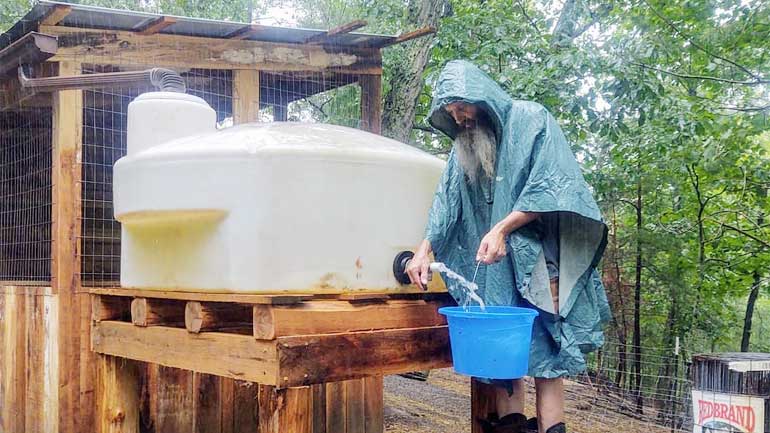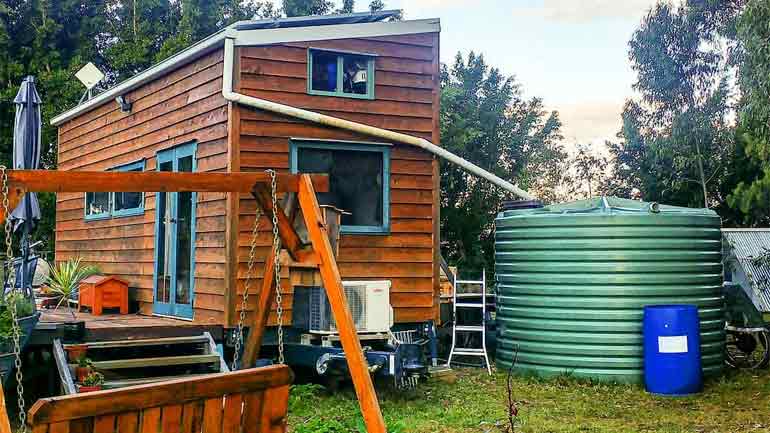
For many, rural rainwater tanks are a necessity, as they may have no access to mains water and need to provide their home’s entire water supply themselves. This is often done through rainwater harvesting alone, combining it with other water harvesting techniques such as dams and lakes or utilizing a windmill or solar pump to provide groundwater for non-potable water around the home, and relying on a smaller rainwater tank for drinking water.
However, there are many people who live in rural areas that are close enough to rural towns who have access to town water supply and don’t need to use a water tank to provide water for their entire household, who might still be interested in installing one for the range of other benefits that come with installing a rainwater tank. The price tag associated with installing a rainwater tank means that it’s only natural to weigh up the decision and find enough associated benefits to justify it.
So what are the benefits of owning rainwater tanks in rural areas if having water storage on your property isn’t a matter of life and death? Well, as with most things; everyone’s circumstances are different and one person’s reason for rainwater storage will be different to another’s. This article sets out to outline a few of these benefits, and how they might work for you.
More water for gardens and lawns
No water restrictions
In many areas – particularly drier areas, or places where the water supply hasn’t been able to keep up with population growth and the water usage that comes along with it – there are water restrictions in place, either all year or just in the summer months. These restrictions do a great job of lowering mains water usage in times where rainfall isn’t as high as it should be, and encourage watering lawns at more effective times, such as early morning or twilight.
A great way to get around this – particularly if you have the type of garden that won’t survive the lack of rainfall without regular sprinkler water – is to install a water tank. If you are looking to have this tank only for garden use, then a small poly water tank like slimline tanks will likely be enough to cover the rainwater supply needed for your garden.
If you’re concerned that the rainwater collection that these smaller plastic or steel slimline tanks provide isn’t quite enough to tide you through the summer months, then you may look into round tanks if you can justify the space they consume.
Better for your plants and gardens
Have you ever noticed how plants often look a bit fresher, greener, and healthier after a good rainfall? Many studies have shown that rainwater is more beneficial for plants than tap water, and this is for a number of reasons – not just because they prefer the taste like a lot of people do.
The first reason is that rainwater is much softer than tap water. Tap water has chlorine and fluoride added to it, primarily for health purposes; chlorine as a disinfectant, and fluoride to help prevent cavities. Tap water can also pick up trace amounts of calcium and magnesium, which you may notice build-up on plumbing and taps, and can also leave white sediment on leaves.
Thanks to the lack of the presence of these chemicals in rainwater, its nitrogen, oxygen, and carbon dioxide content is much higher. Nitrogen is often utilised in fertilisers as it has beneficial attributes to both leaves and roots. The oxygen content helps prevent saturation of the plant’s roots, which can occur due to overwatering with tap water, leading to root rot. The carbon dioxide in rainwater helps the raindrops become slightly acidic, helping release micro-nutrients like copper, manganese, iron, and zinc from the soil, which are beneficial to plant health and growth.

The environmentally friendly water storage solution
Prevents water loss due to evaporation
Many rural properties use dams or watering holes as a major water storage solution, particularly for stock watering and non-potable water. In Australia alone, there are over 2 million dams with a combined eight trillion litre capacity. While these provide a crucial water supply, the large amount of surface water means that some of these dams lose up to 50% of their stored water in evaporation alone.
Concrete tanks and large steel tanks provide a partial solution to this, allowing this water to be stored somewhere it will not evaporate, as the roof of the tank prevents the water loss that is experienced in dams. Both of these tanks feature incredible wall strength, however, the steel water tank is proving more popular in recent times, with a much lower price tag, easier installation, and repair, and the anodes and tank liners fitted to a steel tank helping prevent corrosion.
Reduces demand for other water sources
Every time you use tank water, particularly rainwater, you are reducing the demand on other water sources such as mains water and groundwater. Reducing demand on groundwater supplies helps aquifers underground stay full for longer, and allows underground water systems to operate closer to their natural patterns.
Reducing mains water usage means that the energy associated with water supply will be lessened, as most town water schemes use a lot of power pumping and supplying water to all the homes connected to these systems. If you are able to become fully self-sufficient, you may also be able to get rid of that pesky water bill, as much of this bill is for the supply fee, and moving to a water storage tank for all your water supply needs will potentially allow you to sever this connection.
Rural rainwater tanks protecting against stormwater runoff
Your roof and gutters can play a key role in helping to prevent environmental and property damage caused by rainwater run-off. The introduction of homes, roads, and footpaths to many areas has made it much harder for rainfall to escape and often leads to flooding and widespread damage caused by the built-up water and any debris it may carry along with it.
However, the installation of several water tanks in the area – be it plastic water tanks like poly tank or steel water tanks – can help reduce the build-up of stormwater. If there was a 48-hour period where 100mm of rainfall fell on a small rural town, 100 houses
Your friend in the laundry
Many people who install a small plastic tank are looking to use the water in their toilet and washing machine, as they won’t have to be as conscious about their tank water quality in these places. Not only is this a more environmentally conscious decision, but thanks to rainwater being naturally soft, as mentioned above, this means that you may need to use less laundry detergent to achieve cleaner clothes.
This is because the soaps in laundry detergent react with the calcium and magnesium found in tap water, and when they are absent the detergent doesn’t have to work as hard to remove dirt from the clothes themselves. The soft water also results in a much more effective rinse cycle.
Things to look out for
Check water quality
When installing a water tank, it is good to know what the rainwater in your area is like. In urban areas, rainwater may be more acidic, and in coastal areas, there may be more salt in your water. This knowledge can help you tackle the right materials for your tank and associated plumbing to be made from, and where the water is suitable to be used.
Keep your rainwater harvesting systems clean
To ensure that your stored water remains clean and healthy, it is important to make sure that your rainwater collection systems are free from debris or potential contaminants. Make sure there are no branches overhanging your gutters and contact an arborist to deal with trickier jobs.
Make regular efforts to clean your gutters and related areas of your rainwater systems, including the leaf filter basket located at the inlet of your rainwater tank. This will help prevent any water from becoming contaminated by debris that is unable to enter the tank.
How much water do you need
Important before installing a rainwater tank is to know how much water you can harvest, how much water you need, and how much available space you have to install a water tank. You can even add extra parameters here like what Colorbond colours match your roof or gutters, or what your max budget is. This will make your tank hunting process much easier.
Rainwater storage benefits
It is important to remember that these are just a few of the more common benefits of rainwater storage in rural areas from a much longer list. You may find that there are other far more compelling benefits for yourself that are unique to your circumstances – many people prefer rainwater simply for the taste!
Hopefully, this has given you some idea of what you’re looking for when purchasing a rainwater tank, and maybe even given some added benefits to your purchase.
Good luck, and happy harvesting.




